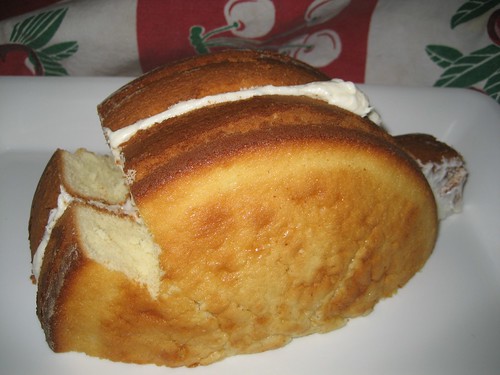If you've been following along on
my personal blog, you already know things have been a slow in my life, as I have a knee to heal. I haven't been tasting new fruits or cooking much of anything, and while baking is my therapy, I'm trying to curb that too since even though I spend almost 2 hours at the gym every day, working out only one leg doesn't burn as many calories as I'd like.
This week our beloved Spanish teacher. Sofía, celebrated her birthday, and as I'm not one to show up to a birthday party empty-handed, I decided to bake cupcakes. Baking cupcakes is no easy feat in Buenos Aires. Muffin tins are hard to come by, to say the least, and paper liners are scarce. But Ken went to the party store (yes, there are party stores! In abundance!) and came home with flan moulds in which to bake the cupcakes. Genius!
And so I spent Friday afternoon, in almost-unbearable heat and humidity, baking vanilla cupcakes for Sofía, because I love her. And I baked them seven at a time, because that's how many flan moulds were available at the party store.

Around 8 p.m. I texted Sofía to get the party details, and found out that I'd misread her email: The party is
next Friday. Oops. What's a girl to do with 16 delicious vanilla cupcakes with chocolate frosting?

Luckily I had plans this afternoon to attend an English-language book exchange, so I brought them along. (It was either that or eat them all, 2 at a time.) And hopefully when I bake them again this Friday, it won't be quite so hot.
Amy Sedaris' Vanilla Cupcakes (recipe from
Epicurious.com)
1 1/2 sticks unsalted butter
1 1/2 cups sugar
2 eggs
2 teaspoons pure vanilla extract
2 1/2 teaspoons baking powder
1/4 teaspoon salt
2 1/2 cups flour
1 1/4 cups milk
Amy's Instructions: Turn oven on to 375 degrees F.
Put butter in mixer and beat at medium speed until somewhat smooth. Pour in sugar and beat well. Add 2 eggs. I like to crack the eggs on the side of the bowl while it is moving, which can be really stupid. I like to take chances. Yes, I have had to throw away my batter because I lost eggshells in the mix. Yes, it was a waste of food and yes, I know how expensive butter is, but what can I say? I'm a daredevil. Mix well. Add: vanilla, baking powder, salt, flour, and milk. Beat until it looks like it is supposed to and pour into individual baking cups, until they are about 2/3 full. Bake for 20 minutes or until golden brown. Should produce 24 cupcakes; I get 18 because I'm doing something wrong, although my cupcakes were voted second best in the city by New York Magazine.
Ed. note: I got 16 1/2 because I'm doing something really wrong, which is called baking cupcakes in flan moulds. And also because I really like cupcake batter.Magnolia-ish Chocolate Frosting150 g bittersweet chocolate (minimum 60%)
75 g butter, room temperature
250 g confectioners sugar (a.k.a. powdered sugar, icing sugar (Canada), or
azucar palpalble (Argentina))
1 t vanilla extract
2-3 T milk
Melt the chocolate using your preferred method of melting (double-boiler, microwave, direct sunlight). Beat in the butter (a mixer works best, but elbow grease works too, and think of how great your arms will look!). Beat in the vanilla, then add the confectioners sugar slowly (or else you'll be covered in it). Keep mixing until it's all mixed together, and then a little longer for good measure. Add milk a little at a time to get the right consistency. I like to taste it along the way - you know, just to make sure it's delicious enough.
I say this is Magnoia-ish because it's not officially their recipe, but it tastes a lot like it. This recipe made just enough frosting for my aforementioned 16 cupcakes, so if your cupcake recipe yielded more, or you just like piles of (very sweet) frosting, adjust away!
 Despite their proliferation in backyards this time of year, crab apples are apparently hard to come by. We visited farms, farm stands, and farmers' markets. I think that was our biggest mistake, actually, because nobody grows these trees on purpose. We'd have been better off visiting area yard sales and surreptitiously gathering the fallen fruit (possibly while simultaneously haggling over the price of a toaster). We finally found some, and negotiated a price of $25/bushel.
Despite their proliferation in backyards this time of year, crab apples are apparently hard to come by. We visited farms, farm stands, and farmers' markets. I think that was our biggest mistake, actually, because nobody grows these trees on purpose. We'd have been better off visiting area yard sales and surreptitiously gathering the fallen fruit (possibly while simultaneously haggling over the price of a toaster). We finally found some, and negotiated a price of $25/bushel. We both sampled a crab apple. This particular variety smells sweet and tastes tart, although not inedibly so. They're not the most efficient snack, though, unless you have a very small mouth.
We both sampled a crab apple. This particular variety smells sweet and tastes tart, although not inedibly so. They're not the most efficient snack, though, unless you have a very small mouth. A local seagull, however, was not so discriminating. After I chucked an excess crab apple onto the sand beside me, he nabbed it and ran off. À chacun son goût.
A local seagull, however, was not so discriminating. After I chucked an excess crab apple onto the sand beside me, he nabbed it and ran off. À chacun son goût. UFF Fruit Rating:
UFF Fruit Rating: 























